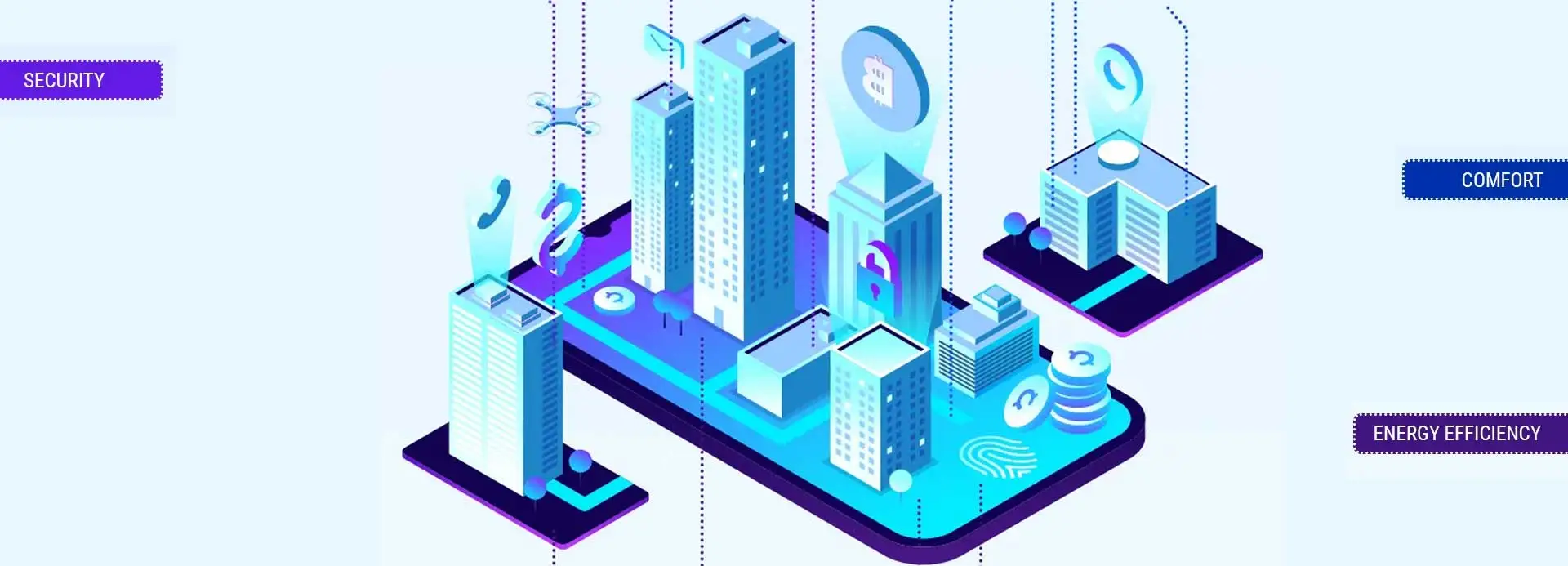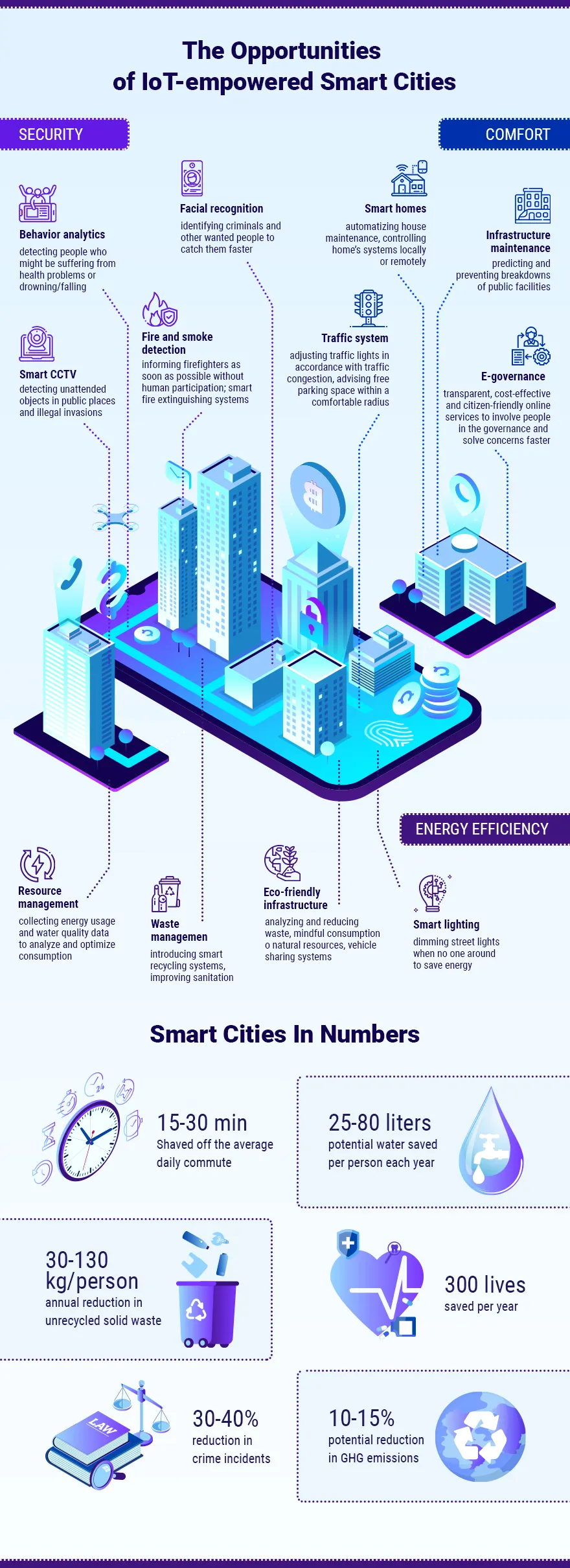

IoT (Internet of Things) has been in the press and media for many years. Even if we are not in technology we know by now what it means or maybe you don’t know. Alos we can hear the IoT is a big thing for Smart Cities. But what does it mean? What opportunities does it offer to the citizens and the urban environment? Today’s post is about that.
IoT-empowered smart city solutions imply the connection and communication between different city objects and systems with the help of sensors. Sensors can collect data on an interval base, can collect data on a certain condition, or simply control some other electronic equipment.
While a lot of the data collected can be used for statistical measurements and are used maybe for future decisions into investments and improvements they should maybe put in motion. This means nothing more than sensor data can be used today to control something or make a decision, this is what we call a use case with benefits.
But here comes already the challenge for a lot of vendors who provide Smart City solutions. The majority of the solutions can only collect data, provide monitoring, and nothing more.
“IoT with a value refers to ‘Use Cases’ which help citizens and governments to easily consume smarter services and provide those in an easy way.“
-Peter Eder, President of TR1ton Group
Another challenge is the limitation of most of the hardware for Smart Cities:
- Sensors passively collect data and send it to a central backend solution
- LoRaWAN is limiting the collection of data and loses 80% of data on a certain range
- High hardware requirements are stretching cities’ budgets and stopping them from implementing solutions
To address the various challenges in implementing and maintaining smart technology, TR1ton Global has pioneered an innovative sensor technology that integrates three major capabilities, each playing a critical role in shaping the future of Smart Cities.
More about Tr1ton Global
The first capability is the ability of smart sensors to make autonomous decisions on-site. This allows the sensors to process data at the source and take immediate action without relying on centralized systems. By enabling real-time decision-making, the sensors can respond to changes in their environment, such as traffic flow, weather conditions, or even emergency situations, helping improve overall city management.
The second capability is the impressive range of TR1ton’s endpoints (sensors). These sensors are capable of sending data over distances of up to 10 kilometers, provided there’s Line of Sight (LoS) between the endpoints. This ensures that data can be transmitted over large areas with minimal interruption or signal degradation. It also means that the sensors can operate over wide geographic areas, such as entire neighborhoods or districts within a city, reducing the need for frequent infrastructure setups like base stations or relay points.
One of the most important aspects of TR1ton’s technology is that it ensures 100% data transmission, meaning there is no loss of information during transmission. This is crucial for maintaining the integrity and quality of data, especially in critical applications such as smart grids, environmental monitoring, and emergency response systems, where even a small loss of data could lead to significant consequences.
The third factor is that TR1ton’s sensors can transmit data not only over long distances but also through physical barriers such as three concrete penetrations. This feature allows for deployment in dense urban environments without requiring numerous additional base stations or antennas. It reduces the cost and complexity of installation, making the technology more accessible to city planners and governments with limited budgets.
For Smart City operators, these advancements offer substantial benefits. By cutting down on the number of base stations required and improving the efficiency of installations, TR1ton’s technology provides a higher Return on Investment (ROI) during the installation phase. Furthermore, due to the low-maintenance nature of the system and its ability to cover larger areas with fewer components, cities can expect a significantly lower Total Cost of Ownership (TCO) during the system’s operational life.
These sensors have a transformative impact on the way cities manage their infrastructure. By exchanging information in real-time and responding to changing conditions, these systems create a cohesive ecosystem where routine processes—such as traffic management, waste collection, energy distribution, and environmental monitoring—are automated and optimized. Cities can become more efficient, responsive, and sustainable, ultimately improving the quality of life for residents.
This shift to smart technology extends beyond just operational efficiency; it also plays a crucial role in addressing environmental challenges. For example, smart sensors can monitor air quality, detect pollution, and manage energy consumption, leading to reduced waste and better management of natural resources. This has significant implications for a city’s carbon footprint and its long-term sustainability goals.
Moreover, as TR1ton’s solutions integrate with other urban technologies, cities become smarter, allowing for coordinated responses to everything from changing weather conditions to public safety threats. The combination of data collection, automation, and real-time responses enables a level of urban management previously unimaginable.
To provide a clearer view of how such solutions improve the lives of city residents and enhance environmental sustainability, the infographic from SC&scand illustrates the numerous ways smart sensor technology benefits both the people living in cities and the ecosystems they depend on. These visual insights showcase the long-term advantages of integrating such technologies into the fabric of urban life.


![At a Glance Guide to Relocation to Dubai [Infographic] hero-image-relocation-dubai](https://www.skillzme.com/wp-content/uploads/2024/12/hero-image-relocation-dubai-200x200.jpg)
![90% of Americans Think iPhone 16 Cost Too Much [Infographic] 90% of Americans Think iPhones 16 Cost Too Much](https://www.skillzme.com/wp-content/uploads/2025/02/hero-image-iphone-16-200x200.jpg)
![United Arab Emitaes (UAE) Population Statistics 2024 [Infographic] hero-image-UAE-Population-Statistics-2024](https://www.skillzme.com/wp-content/uploads/2024/11/hero-image-UAE-Population-Statistics-2024-200x200.jpg)


Recent Comments